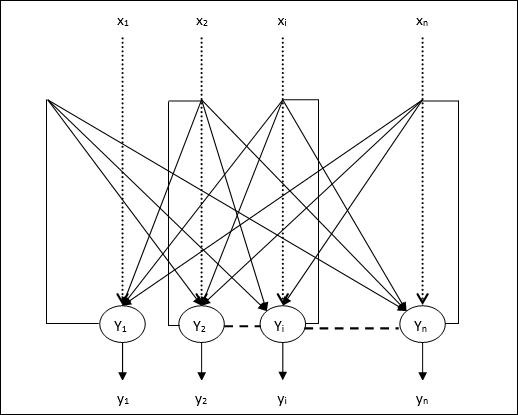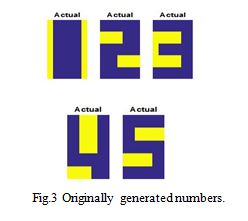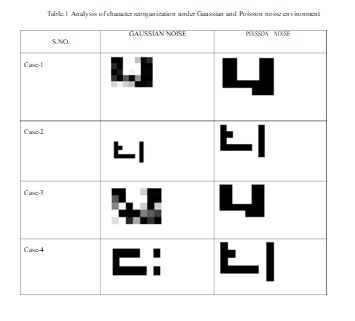1Aarti Khoda, 2Priyanaka Punjabi
1Suresh Gyan Vihar University, Jaipur, Aarti25@gmail.com,
2Suresh Gyan Vihar University, Jaipur, priyankapunjabi10@gmail.com
Abstract: In this paper we are generating the image of numbers from one to five and predicting these numbers using machine learning tool. After predicting the or estimating the number we have choose second number and add the Gaussian noise in that number with two different amounts i.e. 5%, and 50 %.We have seen the effect of noise on the number image. The same experiment was repeated with the Poisson noise environment. Finally we compare between the images affected by Gaussian and Poisson noise.
Keywords: Artificial neural networks (ANN), Image processing, machine learning, neural networks, Hopfield network
I. INTRODUCTION
Image processing is a method in which we extract the information from an image. There are several operations are perform on an image to extract the information. Image processing can be analog or digital. In analog processing we use photocopy, printing, fax, etc. In digital signal processing computer plays an important role in this process. So it always referred as digital image processing. Image processing mainly consist following steps.
- We have to require an image by any source like digital camera, scanner, etc.
- We perform the operation like digitalization of image, image enhancement, image compression etc.
- Get the processed image or output of image by which we made conclusion.
II. INTENTION OF IMAGE PROCESSING
There are several purposes of image processing. These are listed below
- Visualization – detect the substance which is invisible.
- Sharpening and reinstallation of image – It is used to extract a good quality image
- Image recovery – In the several images look for the required image
- Measurement of Image – dealing with different substance from an image.
- Image detection – differentiate the substance in an image.
Fig 1 showing the complete view of image processing

Fig.1 Various steps of image processing
III. MACHINE LEARNING
Machine learning is a part of artificial intelligence (AI) in which system generates the ability to learn from the environment. This technique required computer programming along with statistical tools. In the machine learning process system adopts the information from the external world or from the previous experiences and then improves its own algorithms. It can work efficiently in highly fluctuating or dynamic environment. There are several techniques in machine learning, ANN is one of them. Here in this paper we are working on Hopfield neural networks.
- Hopfield neural networks :
Hopfield neural network is a type of artificial neural network which is discovered in1982 by Dr. John J. Hopfield. It consists of a single layer which contains one or more fully connected recurrent neurons. The application of Hopfield neural network is in character reorganization, pattern classification problems or in auto association optimization problems..
In the Hopfield neural network the input vector and output vectors are in the discrete form. The input can be classified into binary (0,1) or bipolar (+1, -1) form.. The network has symmetrical weights with no self-connections i.e., wij = wji and wii = 0. Network architecture is shown in Fig 2.

Fig.2 Hopfield Network Architecture.
IV. CHARACTER REORGANIZATION.
In this research work we have generated the numerical characters from 1 to 5. All these characters are the input of our program. These numbers were in the form of vector. For the digital processing on these numbers we converted them into matrix data. The generated numbers are showing in Fig 3.

In the next stage we have apply the Hopfield network algorithms to predict the input characters. The output result is showing in Fig. 4

By Fig.3 and Fig 4. We can say that Hopfield network is predicting the accurately in case of 1,3 and 4 but we are getting 2 as distorted and it is 3 to the number 5.
Now here we have taken two category of analysis
- -1 : adding Gaussian noise
- Cat.-2: adding Poisson noise.
In each category we have four cases
- Case-1 : adding 5% noise in the data
- Case -2: predict the result after adding 5% noise
- Case-1: adding 50% noise in the data
- Case -2: predict the result after adding 50% noise
The summary of all the results is shown in table-1
By table-1 we can see that Gaussian noise is affecting more to the characters as compared to the Poisson noise. Similarly recovery of the image using machine learning is also providing the good result in all the cases. Little bit error is also associate here but still it s a good result.
V. CONCLUSION
Here in this paper we have seen the effect of Gaussian and Poisson noise over the different characters and we have predicted our result by using Hopfield network. We found satisfactory prediction of characters. Here we can also use various algorithms for the prediction.
VI. REFERENCES
- Zhang, H. Wang, S. Liu and B. Xiao, “Deep Contextual Stroke Pooling for Scene Character Recognition,” in IEEE Access, vol. 6, pp. 16454-16463, 2018.
- A.Benafia, S. Mazouzi and S. Benafia, “Proposition of a graphic model with features for hand written character recognition,” 2017
- S. Pachpande and A. Chaudhari, “Implementation of devanagri character recognition system through pattern
recognition techniques,” 2017 International Conference on Trends in Electronics and Informatics (ICEI), Tirunelveli, 2017, pp. 717-722. - K. Vijayalakshmi, S. Aparna, G. Gopal and W. J. Hans, “Handwritten character extraction,” 2017 International
Conference on Wireless Communications, Signal Processing and Networking (WiSPNET), Chennai,
2017, pp. 1178-1181. - S. K. Ingole and S. B. Gundre, “Characters feature based Indian vehicle license plate detection and ecognition,” 2017 International Conference on Intelligent Computing and Control (I2C2), Coimbatore, 2017, pp. 1-5
- R. Kajale, S. Das and P. Medhekar, “Supervised machine learning in intelligent character recognition of handwritten and printed nameplate,” 2017 International Conference on Advances in Computing, ommunication and Control (ICAC3), Mumbai, 2017, pp. 1-5
- A. Benafia, S. Mazouzi and S. Benafia, “Proposition of a graphic model with features for handwritten character
recognition,” 2017 International Conference on Engineering and Technology (ICET), Antalya, 2017, pp. 1-14.

